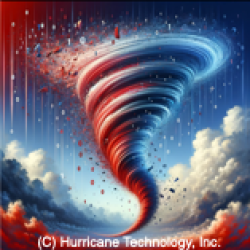If your city is growing at 5% per year, is this a good thing? What will the size of the city be in 10 years? Is that a linear or exponential growth? If your checking account has a 10% interest rate, how long until you double your money? All good questions.
It’s been said that no layperson understands exponential growth and unfortunately, if that’s true, then neither do the media or popular TV shows. Try to explain exponential growth to someone and you may be greeted by a blank stare. Why does any of this matter?
First things first…
What is an exponential function?

An initial explanation might be that exponential growth is when something is growing at a very fast (non-linear) rate though possibly not noticeable initially. In normal everyday life we tend to think of things linearly getting faster, slower, bigger or smaller, but at a constant rate. Exponential growth is different. It is not linear as it gets very large, or quick, at some point, and that point is sooner than you might think.
In high school, most students learned about functions like 2^x (or, “2 to the x”: 2 raised to the power of x). Here, we have an exponential function since the variable is in the exponent itself. Having a variable that increases while in the exponent is the basis of what an exponential function is. Of course, things can, and usually do, get more complicated, but understanding the variable in the exponent is a the first step.
Graph — Look at the data vs. the graph below to see how the graph changes exponentially vs linearly

Note that the linear portion (right side) of the graph has the variable “x” not in the exponent. The linear portion has a line with constant slope.
Why does it matter?
Exponential growth is everywhere. Understanding it is important not only for day to day activities, but to understand how things work. Something that may not seem to matter with a few trials may actually be extremely important once proper analysis is done.
Examples?
Example1: Your bank’s interest rate on your investments.
Simple Interest: Simple interest is when you get, say, 10% per year (or other fixed amount) interest on your account or investment. Not much going on there. With a $100 principal amount, that’s just $10 per year. Easy. So, if your initial amount, or P, was $100, you would have $10+$10+$10+$10+$10 more in five years. Simple interest, or $100 + $50 = $150. The interest is growing linearly. If you looked at the formula for simple interest, you’d see there is no variable in the exponent.
Compound Interest: Compound interest gets more interesting, since the interest, if compounded yearly (or otherwise), takes into account all the money you’ve earned (including the previous interest) to calculate your future amount. A quick example.
Using the formula: Balance = P * (1 + r) ^ n, where P is the principal amount, r is the interest rate, and n is the number of compounding periods. Here, exponential growth quickly outpaces simple linear growth. If we start with the same values and assume a 10% interest rate, we would have:
Balance = 100 * (1 + 0.1) ^ 5 = $161.
Not impressed yet? How about after 10 years?
Balance = 100* (1+0.1) ^ 10 = $259.
—
The side question often comes up as to how long it would take to double your money (dust off your college algebra for this one…)
M = P (1+i)n
Say you start with $100 and a 10% interest rate compounded yearly. How long would it take to double your money?
200 = 100 (1+i)n
2 = (1 + 1)n
or
log(2) = n log(1.1)
n = log(2)/log(1.1)
napprox = 7.28 years. (to double your money)
With compound interest, the money you earn is growing exponentially, not linearly.
Albert Einstein was supposedly quoted as saying the most powerful force in the universe is compound interest.
—————————
Example 2:
Doubling your money every day for thirty days starting with just one penny.
Say someone offered to give you (A) $500,000 or a (B) penny and double it every day for 30 days. Which would you take A, or B?
If you chose B, you’d be a lot better off since that daily penny doubling goes like this:
Day: Pennies
———————————————————
1 1
2 2
3 4
4 8
5 16
.
.
.
…
30 536870912 pennies, or dividing by 100, $5,368,709.12 (over 5 million dollars!)
—————————
Example 3:
Paper Folding until you reach the Sun
Assuming you could physically fold a piece of paper in half over and over, how many folds would it take you to reach the Sun? We can see that this is as 2^x exponential growth since each fold is doubling the paper thickness. We quickly realize that there is no way we could “physically” fold the paper in half more than a few times, but what if we could, at least theoretically? How many folds would it take to reach the Sun? You might (incorrectly) assume it would take too many folds since folding the paper once, then twice, then three times, doesn’t amount to much. Ah, but that’s the problem with exponential growth: the growth kicks in later.
Here are some possible answers to the question about how many folds, approximately, it would take to reach the Sun (which is closest).
What’s your guess?
A. 50
B. 500
C. 5,000
D. 5,000,000
Guesses?
Well, if you answered A or 50, you’d be right.
Here is the output of a computer program that actually computes this paper folding (you could get the same result manually).
We assumed the thickness of a piece of paper is 0.0001 feet and the distance to the Sun is 491,040,000,000 feet.
Let’s start folding…. (notice that nothing really happens on the first 10 to 12 folds, but then, with exponential growth, it gets interesting)
Let’s calculate this!

Number of Paper Folds so far: 1, distance traveled toward the Sun: 0.0002 feet
Number of Paper Folds so far: 2, distance traveled toward the Sun: 0.0004 feet
Number of Paper Folds so far: 3, distance traveled toward the Sun: 0.0008 feet
Number of Paper Folds so far: 4, distance traveled toward the Sun: 0.0016 feet
Number of Paper Folds so far: 5, distance traveled toward the Sun: 0.0032 feet
Number of Paper Folds so far: 6, distance traveled toward the Sun: 0.0064 feet
Number of Paper Folds so far: 7, distance traveled toward the Sun: 0.0128 feet
Number of Paper Folds so far: 8, distance traveled toward the Sun: 0.0256 feet
Number of Paper Folds so far: 9, distance traveled toward the Sun: 0.0512 feet
Number of Paper Folds so far: 10, distance traveled toward the Sun: 0.1024 feet
Number of Paper Folds so far: 11, distance traveled toward the Sun: 0.2048 feet
Number of Paper Folds so far: 12, distance traveled toward the Sun: 0.4096 feet
Number of Paper Folds so far: 13, distance traveled toward the Sun: 0.8192 feet
Number of Paper Folds so far: 14, distance traveled toward the Sun: 2 feet
Number of Paper Folds so far: 15, distance traveled toward the Sun: 3 feet
Number of Paper Folds so far: 16, distance traveled toward the Sun: 7 feet
Number of Paper Folds so far: 17, distance traveled toward the Sun: 13 feet
Number of Paper Folds so far: 18, distance traveled toward the Sun: 26 feet
Number of Paper Folds so far: 19, distance traveled toward the Sun: 52 feet
Number of Paper Folds so far: 20, distance traveled toward the Sun: 105 feet
Number of Paper Folds so far: 21, distance traveled toward the Sun: 210 feet
Number of Paper Folds so far: 22, distance traveled toward the Sun: 419 feet
Number of Paper Folds so far: 23, distance traveled toward the Sun: 839 feet
Number of Paper Folds so far: 24, distance traveled toward the Sun: 1,678 feet
Number of Paper Folds so far: 25, distance traveled toward the Sun: 3,355 feet
Number of Paper Folds so far: 26, distance traveled toward the Sun: 6,711 feet
Number of Paper Folds so far: 27, distance traveled toward the Sun: 13,422 feet
Number of Paper Folds so far: 28, distance traveled toward the Sun: 26,844 feet
Number of Paper Folds so far: 29, distance traveled toward the Sun: 53,687 feet
Number of Paper Folds so far: 30, distance traveled toward the Sun: 107,374 feet
Number of Paper Folds so far: 31, distance traveled toward the Sun: 214,748 feet
Number of Paper Folds so far: 32, distance traveled toward the Sun: 429,497 feet
Number of Paper Folds so far: 33, distance traveled toward the Sun: 858,993 feet
Number of Paper Folds so far: 34, distance traveled toward the Sun: 1,717,987 feet
Number of Paper Folds so far: 35, distance traveled toward the Sun: 3,435,974 feet
Number of Paper Folds so far: 36, distance traveled toward the Sun: 6,871,948 feet
Number of Paper Folds so far: 37, distance traveled toward the Sun: 13,743,895 feet
Number of Paper Folds so far: 38, distance traveled toward the Sun: 27,487,791 feet
Number of Paper Folds so far: 39, distance traveled toward the Sun: 54,975,581 feet
Number of Paper Folds so far: 40, distance traveled toward the Sun: 109,951,163 feet
Number of Paper Folds so far: 41, distance traveled toward the Sun: 219,902,326 feet
Number of Paper Folds so far: 42, distance traveled toward the Sun: 439,804,651 feet
Number of Paper Folds so far: 43, distance traveled toward the Sun: 879,609,302 feet
Number of Paper Folds so far: 44, distance traveled toward the Sun: 1,759,218,604 feet
Number of Paper Folds so far: 45, distance traveled toward the Sun: 3,518,437,209 feet
Number of Paper Folds so far: 46, distance traveled toward the Sun: 7,036,874,418 feet
Number of Paper Folds so far: 47, distance traveled toward the Sun: 14,073,748,836 feet
Number of Paper Folds so far: 48, distance traveled toward the Sun: 28,147,497,671 feet
Number of Paper Folds so far: 49, distance traveled toward the Sun: 56,294,995,342 feet
Number of Paper Folds so far: 50, distance traveled toward the Sun: 112,589,990,684 feet
Number of Paper Folds so far: 51, distance traveled toward the Sun: 225,179,981,369 feet
Number of Paper Folds so far: 52, distance traveled toward the Sun: 450,359,962,737 feet
Total Number of Paper Folds without going past the sun was: 52
WOW.
Conclusion.
Exponential growth is all around you. We use it in so many things in everyday life we sometimes aren’t aware it’s there.
People say (typically on “the news”) that things are (loosely speaking) “exponentially” bigger worse or whatever. This loose terminology is, unfortunately, slang for “getting really bigger! (or worse, etc.)”. In many of the circumstances where you might hear exponential growth used (again, often, sadly, in the media), the growth is really not exponential. Note that a^x type function is also geometrically increasing since it’s a constant raised to a power.
We recently blogged another example of how exponential growth works when using a longer and longer key space with an iPhone passcode. With six characters and only numbers we had 6^10 permutations, but with letters and numbers (lower case) we had 6 ^ 32 permutations. Thus, the key space is getting larger exponentially (since the exponent has the number of letters possible) but it’s getting larger linearly with the passcode length itself.
Exponential growth is not difficult to understand and it’s everywhere!
Enjoy!
——–
Please read our disclaimer available from our home page




